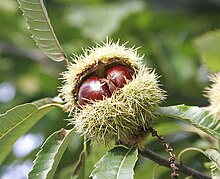It was only after making this soup that I noticed the recipe had been published by the Guardian newspaper in an article on 'The 10 best soup recipes', scroll down several screens of the article to reach the recipe for chestnut soup. The picture included by the Guardian shows a far chunkier version than that included in the book, and mine is even more finely 'mashed', so I guess you should just make your version as coarse or as smooth as you like. Otherwise the recipe published in the Guardian is as printed in the book 'Moro'.
The authors of Moro The Cookbook run a moorish style restaurant in London also named Moro (as well as another more casual tapas style one named Morito) and they have produced three books featuring their personal style of Spanish/North African cuisine. I noticed from their website that this soup was on their 2015 xmas menu, and if you have any vacuum pack chestnuts left over from Christmas this is a great way to use them.
There was a very strong influence from North Africa on Spanish food and this soup is a good example of that. Chestnuts are native to Spain, but saffron and pimento spicing come from Arab and North African invaders.
You will see a lot of Spanish dishes that include small amounts of pork, as does this soup with the addition of chorizo. The explanation I have read for that is that during the reconquest of Spain by the Christians from the north, those Muslims and Jews that stayed in Spain were forced to convert to Christianity, and were made to eat pork. Their meals would be checked by the Inquisitors to see if pork was included so to comply the Moors and Jews would add tiny pieces of pork products to their dishes. For some very useful reading on influences to Spanish food this very comprehensive recipe book The Food of Spain by Claudia Roden is excellent.
I have made this soup both with vacuum packed whole chestnuts and an unsweetened chestnut puree, and although they both produced excellent soups the texture and appearance was mush better using the whole chestnuts. You could of course use fresh chestnuts, and as of mid January there are still some in my local shops (although they come from China, not Europe). Chestnuts are beautiful things, but really quite hard work to prepare for eating. I have read that pigs would feed off them in the forests; they must have had tough mouths!

This chestnut soup is quite filling but in my world not too filling as not to benefit from being served with a little bread.
I have very few recipes for Spanish bread but I was delighted with the results of this one.Rustic Spanish Bread is a recipe from a tv series that the 'Hairy Bikers' (2 motorbike mad men from the north of England) made called 'Bakeation'. I thought this was one of their best tv series as I loved seeing all of the European bakeries they went into to watch traditional breads and other savoury dished being made. A number of the recipes are on the BBC website. This year they presented another great series on the Baltics and some recipes from that series are here Hairy Biker's Northern Exposure. This 'rustic' bread recipe includes some wholewheat flour and uses a slow rise as it incorporates a starter dough that you prepare the day before baking. Do not be put off by the two day process as the resulting bread is quite delicious.
I found to my dismay that chestnut soup is hard to photograph with the dull brown colour of the chestnuts not selling themselves too well at all. Below is my first version using the chestnut puree.
Otherwise both the bread and soup were made as printed in the linked recipes above.
So the next stop on the soup tour is Cuba! Apparently Cuba is now quite a tourist destination and the postcard below was sent to me last summer from British friends visiting the Trinidad part of the island. That famous Spanish explorer Christopher Columbus landed in Cuba in 1492 with the conquest of the island by the Spanish taking place in the early 1500's.
As well as the food brought by the Spanish, the African slaves they brought to Cuba have also had an influence on the island's cuisine. Cuba is a tropical island which has a strong bearing on what can be grown there.
I shall be making a Cuban black bean soup and baking up some Cuban bread.









No comments:
Post a Comment